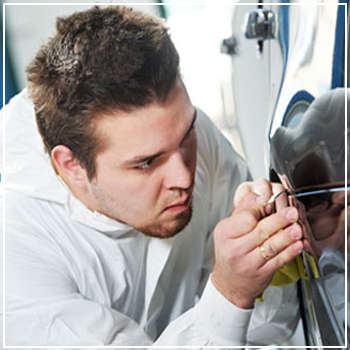 Car lovers and DIYers often grab a paint kit from the auto store to refresh their vehicle's look. But over time, issues like rust, bubbles, or dents can pop up. Painting over them again might seem like a quick fix, but it rarely solves the problem.
Car lovers and DIYers often grab a paint kit from the auto store to refresh their vehicle's look. But over time, issues like rust, bubbles, or dents can pop up. Painting over them again might seem like a quick fix, but it rarely solves the problem.
That’s where professional painting comes in. A skilled painter working in a controlled environment like a spray booth can make all the difference. Not only does it improve the appearance, but it also prevents future problems that DIY attempts may cause. So, what happens if you skip a proper paint job or wait too long to repaint?
Bleeding
Bleeding is when the old paint color shows through the new topcoat, creating a mottled or uneven look. This usually happens when the surface isn’t properly prepared or when a lighter color is applied over a darker one. To avoid this, always sand the old paint and apply a primer before adding the new coat.
Die Back or Dulling
Over time, your car’s shiny finish can lose its luster and become dull or matte. This is especially common if you don’t reapply the topcoat regularly. Poor solvent evaporation or improper curing of the first coat can speed up the process, making your car look older than it is.
Dirt & Debris
When painting outside, tiny particles like dust and dirt can easily get trapped in the paint. This leads to a rough, bumpy finish. That’s why professionals use enclosed spray booths—these environments keep contaminants away, ensuring a smoother, cleaner result.
Air Trapping
“Fish eyes†are small, circular imperfections caused by air bubbles trapped under the paint. They often happen when the surface isn’t clean, there’s leftover wax, or the spray equipment has contamination. Always make sure the car is fully cleaned and the tools are in good condition before starting.
Orange Peel
Orange peel texture refers to a bumpy, uneven finish that looks like the skin of an orange. It occurs when the paint dries too quickly, preventing it from flowing smoothly. This can be due to incorrect spray gun settings, extreme temperatures, or poor drying between coats.
Running and Sagging
Paint running down the sides of the car creates thick, uneven areas once dry. This is often caused by applying too much paint at once, not allowing the base coat to dry, or painting in cold weather. Take your time and follow the manufacturer’s guidelines for best results.
Fading
Exposure to sunlight without proper protection can fade your car’s paint over time. If you park outdoors frequently, regular washing and waxing are essential to maintain the finish and protect against UV damage.
Wrinkling
Wrinkling, or lifting, happens when the new paint layer shrivels up during application. This is usually due to incompatible coatings or not letting the base coat dry completely. Always check compatibility and allow proper drying times between layers.
Edge Mapping
This issue occurs when solvents from the topcoat seep into the undercoats, causing wrinkling around the edges. It’s often the result of using low-quality primers or sealers that don’t provide a strong enough barrier.
Cracks or Crow’s Feet
Cracks in the paint can form if a coat is too thick or if too much hardener was used. These cracks can even show through new paint if they weren’t properly addressed before repainting.
Peeling
Like with house paint, if the car’s paint doesn’t dry properly, it won’t stick well. Over time, the layers begin to separate and peel off. Proper preparation and drying times are key to avoiding this issue.
Mottling
Mottling is a streaky or patchy appearance, especially with metallic finishes. It can occur from improper spraying techniques, such as unbalanced patterns, incorrect spray gun angles, or not allowing the paint to dry between coats.
If your car’s paint is looking rough, faded, or uneven, it’s time to call in the experts. Book an appointment today with DaSilva’s Auto Body and get the professional finish your car deserves!
Air Cooler,Condenser Unit,Industrial Evaporative Cooler,Evaporative Cooler
TAIZHOU NANFENG COLD-CHAIN CO., LTD , https://www.windpolar.com